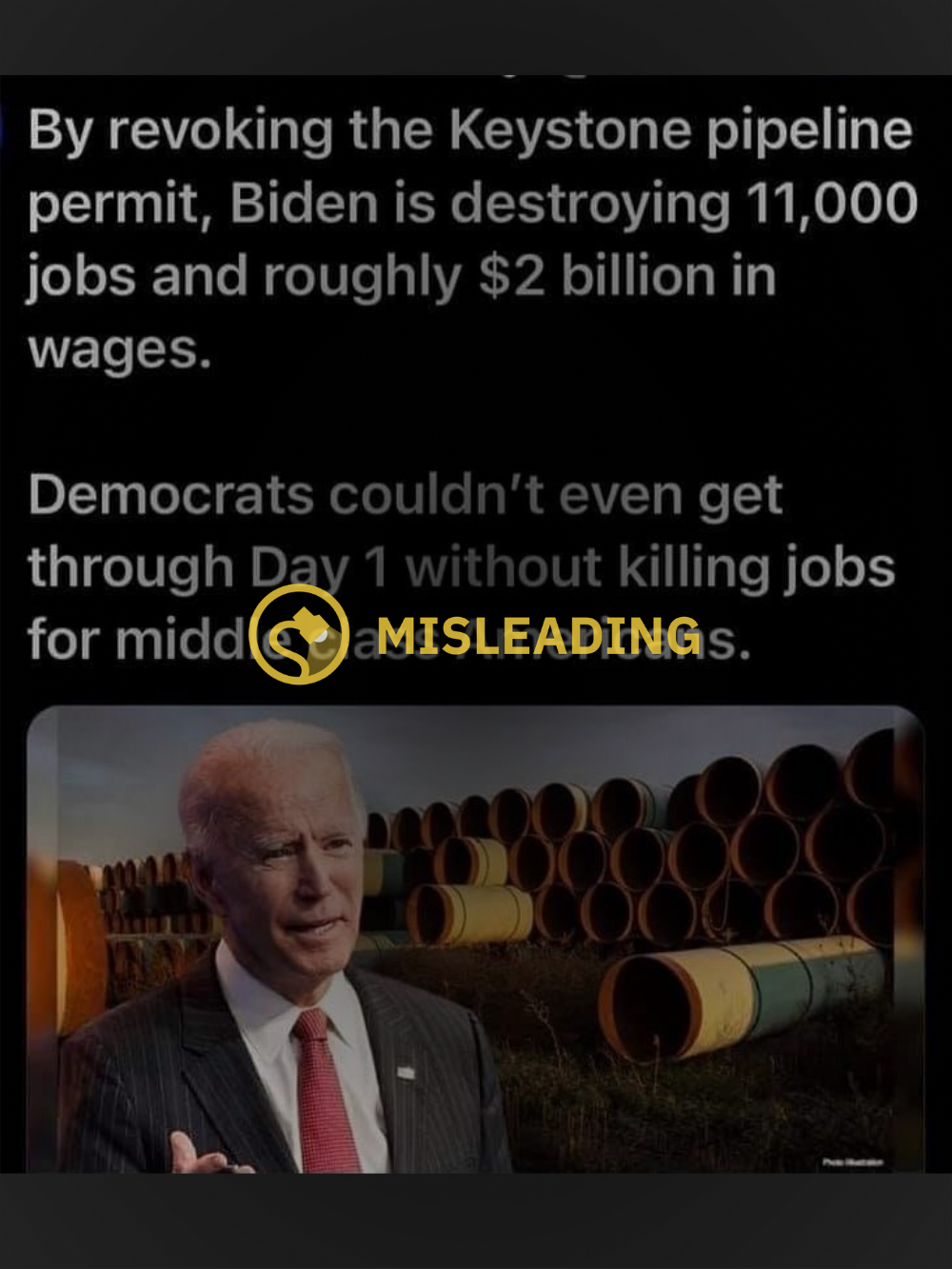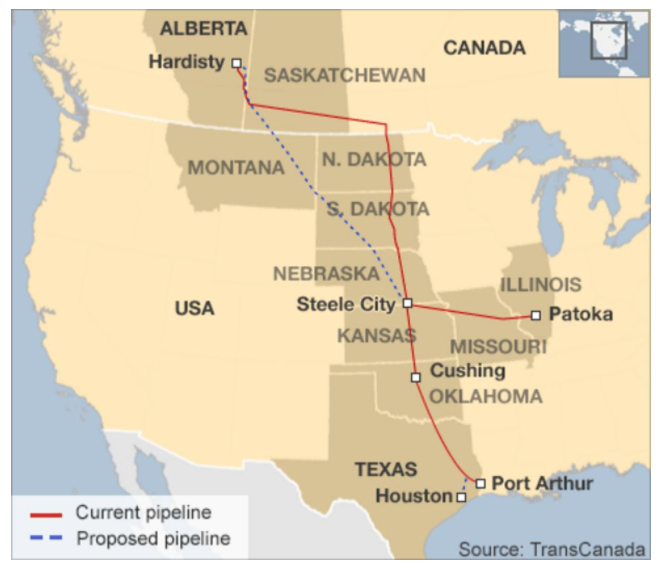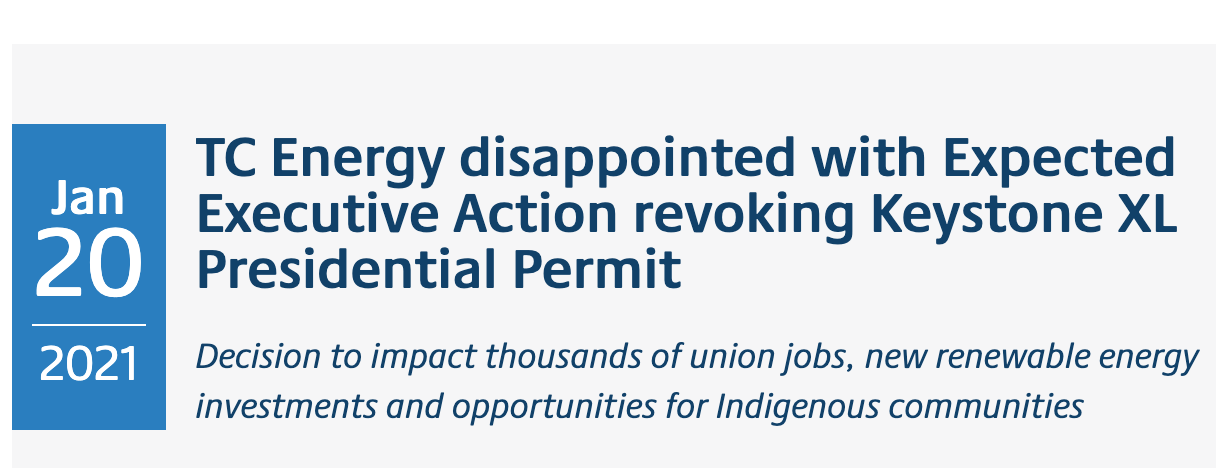In October 2020, TC Energy, the firm behind the pipeline, projected that it would hire 11,000 people to work on the pipeline in the coming year. Additionally, two union leaders said 1,000 members would immediately lose their jobs and another 10,000 future positions will no longer exist, totaling 11,000, as a result of Biden's order.
However, there was no evidence to definitely prove if, or to what extent, 11,000 positions would have been filled without Biden's order, considering multiple hurdles for pipeline proponents.
The exact number of jobs eliminated, or employment opportunities that were planned for but won't be created because of Biden's decision, remained unknown.
After U.S. President Joe Biden signed an executive order to stop construction on the Keystone XL oil pipeline on Jan. 20, 2021, numerous readers asked Snopes to investigate the decision's impact on jobs.
Specifically, Biden's critics circulated tweets and memes that claimed the new president was "destroying 11,000 jobs" by halting the massive infrastructure project.
First, let us provide some background on the pipeline. Proposed in 2008, the 1,200-mile Keystone XL would mostly match the route of an already existing oil pipeline (Keystone), though take a more direct path from Nebraska to Alberta, Canada, and provide a new extension on the Gulf Coast of Texas. See the below-displayed map, created by BBC:
However, citing a pact with other countries to try to decrease global fossil fuel emissions that perpetuate climate change — as well as fierce opposition from American environmentalists and Native American groups — former President Barack Obama's administration nixed the project.
Now, let's explore early projections for jobs. In fall 2015, former Secretary of State John Kerry wrote the following in a 32-page document that affirmed the former administration's opposition to the pipeline:
Construction spending on the proposed Project was found to support a combined total of approximately 42,100 jobs throughout the United States for the up to two-year construction period. Of these jobs, approximately 16,100 would be direct jobs supported at firms that are awarded contracts for goods and services, including construction, by Keystone. The other approximately 26,000 jobs would result from indirect and induced spending. [...] About 12,000 jobs, or 29 percent of the total 42,100 jobs, would be supported in Montana, South Dakota, Nebraska, and Kansas.
Of the 42,100 supported jobs described above, approximately 3,900 (or 1,950 per year if construction took two years) would comprise a direct, temporary, construction workforce in the proposed Project area. Employment supported by construction of the proposed project would translate to approximately 2.05 billion in employee earnings. Of this, approximately 20 percent ($405 million in earnings) would be allocated to workers in the proposed Project area. The remaining 80 percent, or $1.6 billion, would occur in other locations around the country.
According to Keystone, once the proposed Project enters service, operations would require approximately 50 total employees in the United States: 35 permanent employees and 15 temporary contractors.
In other words, federal leaders estimated the pipeline would generate 42,100 jobs over two years, including jobs directly related to the oil pipeline (construction crews, engineers, operators, etc.) and unrelated positions that would be a product of, or support, the new oil pipeline.
Additionally, the Obama administration estimated that two years of construction would generate about $2.05 billion in employee earnings, most of which would go into the pockets of entities nationwide rather than pay workers along the proposed project's route.
Also, of the former administration's estimated job total, about 3,900 jobs would be temporary construction gigs, and only about 50 people (including both full-time and temporary contractors) would work as operators when, or if, construction finished and the pipeline was up and running.
Meanwhile, project leaders estimated the project would add about 13,200 construction jobs across the U.S. and Canada — including both full-time jobs and contracted positions — as well as positively add to the countries' employment rates indirectly. The Keystone XL website stated, as of this writing:
Construction of Keystone XL will directly create an estimated 13,200 (U.S., 10,400, and Canada, 2,800) high-quality jobs and local contracting opportunities. [...]
Overall, construction will support nearly 60,000 (U.S., 42,000 and Canada, 17,000) direct, indirect and induced employment opportunities generated by the business that will be created supplying goods and services to the project and the project’s workforce.
Cue Obama's successor, former President Donald Trump, who made it a hallmark of his presidency to revive construction on Keystone XL.
Did Workers Actually Fill Those Jobs?
Within the first few days of his presidency in 2017, Trump claimed the project would create 28,000 jobs, "great construction jobs," even though his own State Department put the number lower, at about 16,000 jobs total, the Washington Post found.
Based on that news outlet's calculations, the pipeline would create anywhere between 3,900 and 7,000 new positions in construction, specifically, along its proposed route. (For perspective, building the NFL stadium that hosts the Minnesota Vikings in downtown Minneapolis required more construction jobs than those pipeline estimates, totaling more than 8,000, according to the stadium's website.)
With Trump's support, construction crews completed the first section of Keystone XL (a 1.2-mile segment in remote northern Montana) in May 2020, The Associated Press reported.
At the same time, proponents faced various hurdles, including the fact that a Montana federal judge had rejected a permit to build across hundreds of streams and other bodies of water and leaders of Native American tribes were monitoring highways for new construction camps, according to the AP.
In October 2020, the Alberta-based corporation behind Keystone XL, TC Energy, however, announced a win for supporters, saying that it had formed partnerships with six American unionized contractors who were planning to hire about 7,000 workers in 2021, according to a news release on its website.
In total, the TC Energy news release estimated that more than 11,000 people would work on the pipeline in the coming year, supposedly creating more than $1.6 billion in gross wages. These numbers appeared to be the basis of the claim by Biden's critics regarding his Jan. 20 executive order.
Here's a key fact for this analysis, however: It was unclear if, or how many, people actually filled those projected jobs when Biden signed the executive order to halt construction.
We reached out to TC Energy to learn if, or to what extent, it had followed through with the October 2020 pledge to hire 11,000 workers in 2021, and we are waiting for a response.
Who's Been Laid Off?
Responding to Biden's order, Keystone XL President Richard Prior told reporters on Jan. 20 that more than 1,000 jobs, the majority unionized, would be eliminated in the coming weeks, according to The Associated Press.
“We will begin a safe and orderly shut-down of construction,” Prior said.
Terry O'Sullivan, president of the Laborers' International Union of North America (LIUNA), echoed that estimate in a statement, saying 1,000 union jobs "will immediately vanish" and another 10,000 future positions that would have employed union workers will not exist.
A welding foreman named Neal Crabtree, 46, of Arkansas, told Fox News his union was one of four whose members lost work due to the change, though did not elaborate on specific layoff numbers.
Another union steward in Iowa told CBS News that he was laid off because of the presidential order, and a pipeline worker in South Dakota expressed concern about his future employment opportunities.
Meanwhile, TC Energy released a statement on Jan. 20 condemning the decision to halt construction with the below-displayed headline and subhead.
The release said thousands of jobs would be "impacted" — not eliminated or lost — without elaborating further.
Weeks later, in a video interview with Axios that published on Feb. 7, leader of the AFL-CIO union, Richard Trumka, said Biden's decision "will cost us jobs," without providing an exact number of both projected and already-established positions.
He said he agrees with the LIUNA's statement (1,000 jobs immediately lost and another 10,000 future positions forgone), though believes the new administration's approach to curbing fossil fuel emissions that mitigate climate change will create new jobs that exceed those numbers of existing or future jobs lost.
In sum, despite the fact that project leaders anticipated filling 11,000 positions in 2021, there was no evidence to definitively prove that, or that positions (either permanent or temporary construction jobs or indirect employment opportunities) were lost as a result of Biden's order in addition to the more than 1,000 jobs the Keystone XL and LIUNA presidents said were eliminated. For those reasons, we rate this claim a "Mixture" of truthful, misleading, and unproven information.




